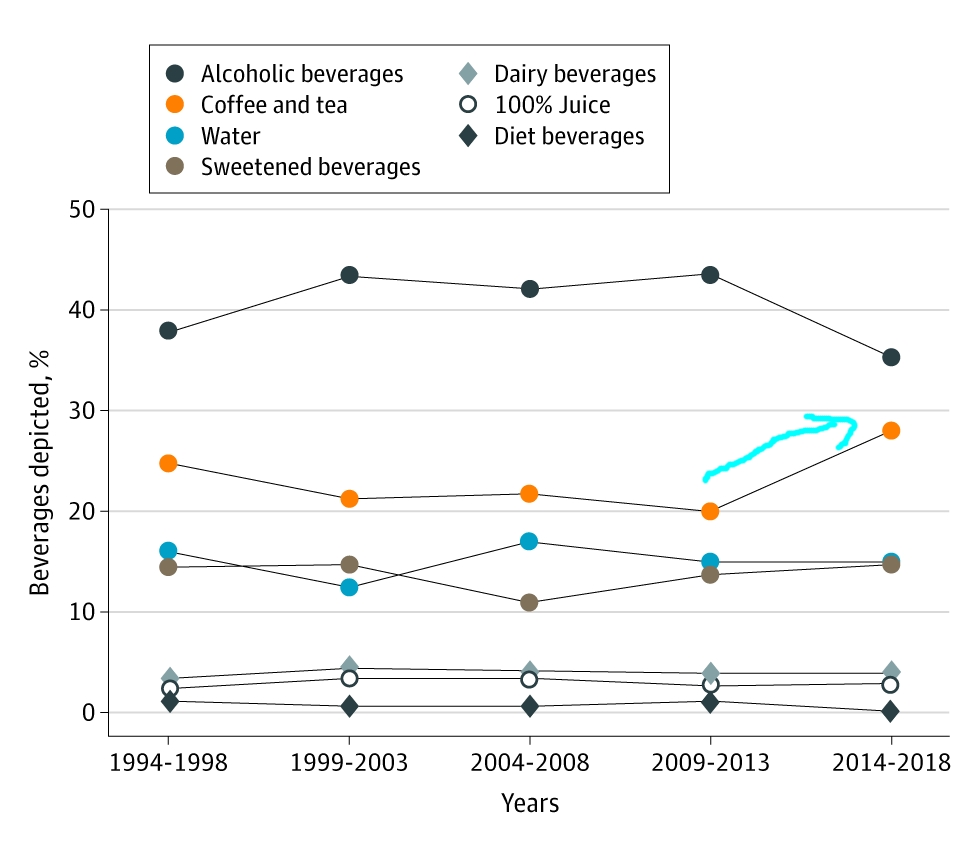Nutritional Analysis of Foods and Beverages Depicted in Top-Grossing US Movies, 1994-2018
Bradley P. Turnwald, JAMA Intern Med. Published online November 23, 2020.
Key Points
Question What is the nutritional quality of foods and beverages depicted in the 250 top-grossing US movies from 1994 to 2018?
Findings This qualitative study found that, across 14 946 foods and beverages, 73% of movies earned less healthy food nutrition ratings and 90% earned less healthy beverage ratings, even though only 12% of foods and beverages were visibly branded products. Moreover, the movie-depicted diet failed federal recommendations for saturated fat by 25%, fiber by 45%, and sodium by 4% per 2000 kcal, featuring 16% higher sugar content and 313% higher alcoholic content per 2000 kcal than US individuals actually consume.
Meaning This study suggests that popular US movies depict an unhealthy diet; depicting unhealthy foods and beverages in media is a sociocultural problem that extends beyond advertisements.
Abstract
Importance Many countries now restrict advertisements for unhealthy foods. However, movies depict foods and beverages with nutritional quality that is unknown, unregulated, and underappreciated as a source of dietary influence.
Objective To compare nutritional content depicted in top-grossing US movies with established nutrition rating systems, dietary recommendations, and US individuals’ actual consumption.
Design and Setting In this qualitative study, a content analysis was performed from April 2019 to May 2020 of the 250 top-grossing US movies released from 1994 to 2018.
Main Outcomes and Measures The proportion of movies with less healthy nutrition ratings using the Nutrient Profile Index, the proportion of movies with medium or high food nutrition ratings according to the United Kingdom’s “traffic light” guidelines (in which green is low and indicates the healthiest foods; amber, medium; and red is high and indicates the least healthy foods), and how the movie-depicted nutritional content compared with US Food and Drug Administration–recommended daily levels and US individuals’ actual consumption according to National Health and Nutrition Examination Survey 2015-2016 data. Secondary outcomes compared branded and nonbranded items and tested whether outcomes changed over time or for movies targeting youths.
Results Across 9198 foods and 5748 beverages, snacks and sweets (2173 [23.6%]) and alcoholic beverages (2303 [40.1%]) were most commonly depicted. Alcohol comprised 23 of 127 beverages (18.1%) in G-rated movies, 268 of 992 beverages (27.0%) in PG-rated movies, 1503 of 3592 beverages (41.8%) in PG-13–rated movies, and 509 of 1037 beverages (49.1%) in R-rated movies. Overall, 178 of 245 movies (72.7%) earned less healthy Nutrient Profile Index food ratings and 222 of 246 movies (90.2%) earned less healthy beverage ratings, which would be unhealthy enough to fail legal limits for advertising to youths in the United Kingdom. Among foods, most movies depicted medium or high (amber or red traffic light) levels of sugar (229 of 245 [93.5%]), saturated fat (208 of 245 [84.9%]), total fat (228 of 245 [93.1%]), and, to a lesser extent, sodium (123 of 245 [50.2%]). Only 1721 foods and beverages (11.5%) were visibly branded, but branded items received less healthy nutrition ratings than nonbranded items. Overall, movies failed recommended levels of saturated fat per 2000 kcal by 25.0% (95% CI, 20.6%-29.9%), sodium per 2000 kcal by 3.9% (95% CI, 0.2%-7.9%), and fiber per 2000 kcal by 45.1% (95% CI, 42.9%-47.0%). Movies also depicted 16.5% (95% CI, 12.3%-21.0%) higher total sugar content per 2000 kcal and 313% (95% CI, 298%-329%) higher alcohol content per 2000 kcal than US individuals consume. Neither food nor beverage nutrition scores improved over time or among movies targeting youths.
Conclusions and Relevance This study suggests that popular US movies depict an unhealthy diet that fails national dietary recommendations, akin to US individuals’ actual diets. Depicting unhealthy consumption in media is a sociocultural problem that extends beyond advertisements and branded product placements.















